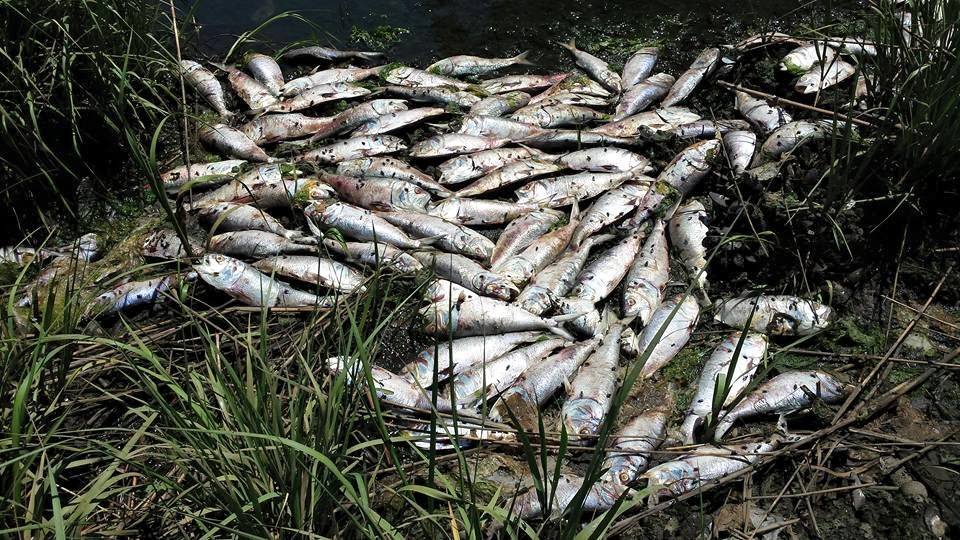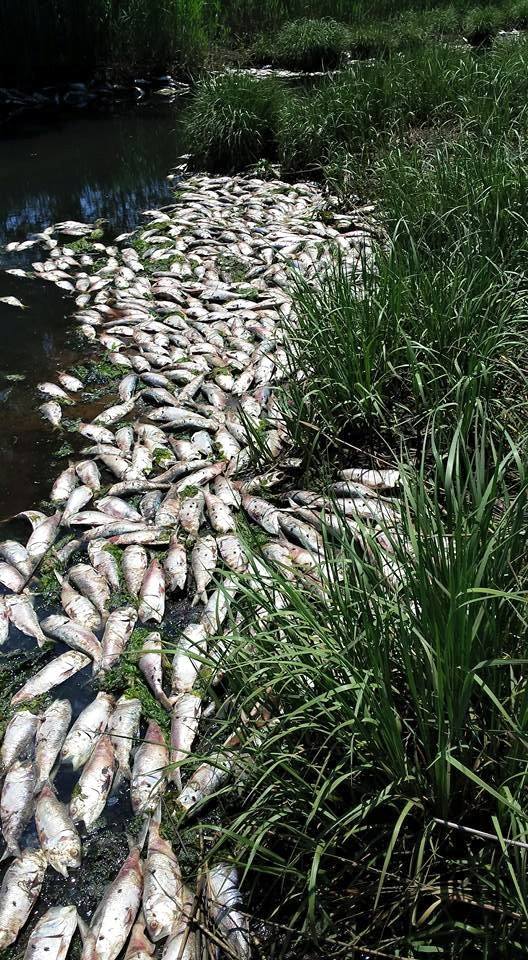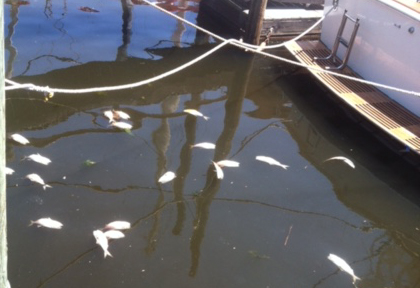Riverhead Town scrambling to fix ‘critical’ situation as fish die off

A recent die-off of bait fish in the Peconic Estuary has Riverhead Town rallying local fishermen to harvest as many bunker as they can before the fish die, according to Supervisor Sean Walter.
“It’s a critical situation,” Mr. Walter said. “We’re having a real problem.”
The die-off has been blamed on low oxygen levels in nearby waters caused by a recent algae bloom, said Christopher Gobler, a biologist at Stony Brook University who’s been investigating the kill.
“This may be the biggest fish kill I’ve ever seen and I’ve been working for more than 20 years,” he told the News-Review.
- How a fish kill unfolds: Scroll down to see
The kill comes weeks after a separate massive die-off of diamondback terrapin turtles, which has also been linked to toxic shellfish likely caused by the algae — also known as red or brown tide.
Mr. Gobler said oxygen levels in the Peconic Estuaries began dropping Wednesday night as the algae became more dense. By Friday, readings from the County Road 105 bridge showed zero oxygen in the water for the fish to breathe.
When a school of bunker swam into this “dead zone,” they suffocated and died, he said. There have been reports of thousands of the dead bunker washing up along town and private beaches.
“This is a pretty remarkable size fish kill,” Mr. Gobler noted. “There were fished piled on top of each other on the shoreline.”
Mr. Walter said that may pose a public safety hazard. While the town is working with the state Department of Environmental Conservation, Mr. Walter said they’ll need to dispose of the dead fish somehow.
 Ideally, the fish would be cleaned up and moved to the Brookhaven landfill, if the DEC allows that, he said. Otherwise, Mr. Walter said he may declare a town-wide state of emergency to clean up the fish and bury them at the town’s own waste facility.
Ideally, the fish would be cleaned up and moved to the Brookhaven landfill, if the DEC allows that, he said. Otherwise, Mr. Walter said he may declare a town-wide state of emergency to clean up the fish and bury them at the town’s own waste facility.
“We’re ready to take action, we just don’t know what action we’re going to take,” Mr. Walter said. “The next 24 hours will tell.”
While the town waits for DEC approval, Mr. Walter said local boat captains have been contacted to round up bunker in the Peconic Estuary before they continue to die off.
Nate Phillips, a commercial fisherman from Greenport, is one of those boat captains. Normally, fishermen are only allowed to take a certain quota of bunker, which are used by lobstermen and other fishermen as bait. Mr. Phillips said those restrictions may be voided during this crisis.
“Obviously, the ultimate goal is to get it cleaned up before they all die,” he said. “When they die they’re a terrible, stinky mess.”
Mr. Phillips told the News-Review he was rounding up a group of fishermen — as many as five or six boats — to harvest the fish using haul seines, scoop nets, or “basically whatever we can get them with.”
The harvest could begin as early as Saturday night.

Mr. Gobler said fish kills are not unusual, but they’re not seen as often in other parts of Long Island where the bunker group together to spawn.
“There’s very few places on Long Island where oxygen levels are going to zero for multiple hours,” he said. “That’s not normal.”
Mr. Gobler said nitrogen runoff likely fed this specific algal bloom, nicknamed “mahogany tide.” Shallow creeks and tributaries of the river are especially vulnerable to algae blooms because the nitrogen gets concentrated in one area.
Historically, the Peconic Estuary has had relatively low oxygen levels to begin with, Mr. Gobler said. With these blooms moving in, the River will “probably have oxygen problems through the summer,” he said.
“It’s going to hit low and no oxygen levels throughout the summer,” he said. “But there may not be the equivalent fish kills because … the fish will sense the low oxygen levels and turn around.”









